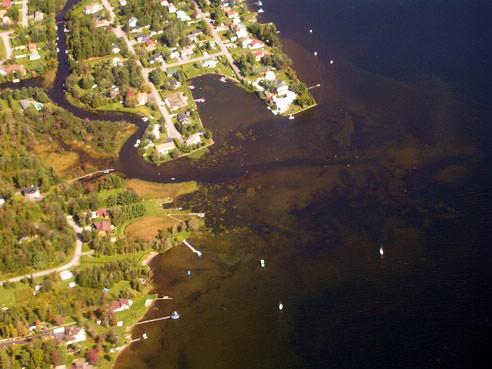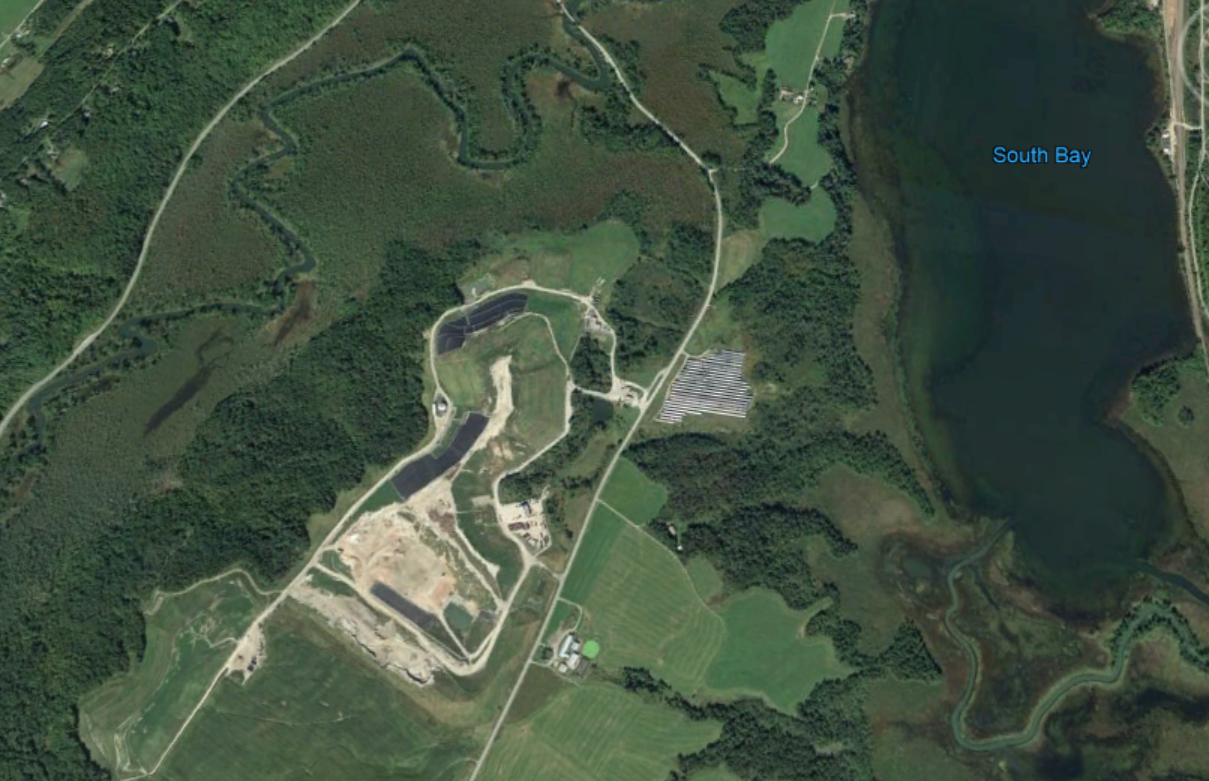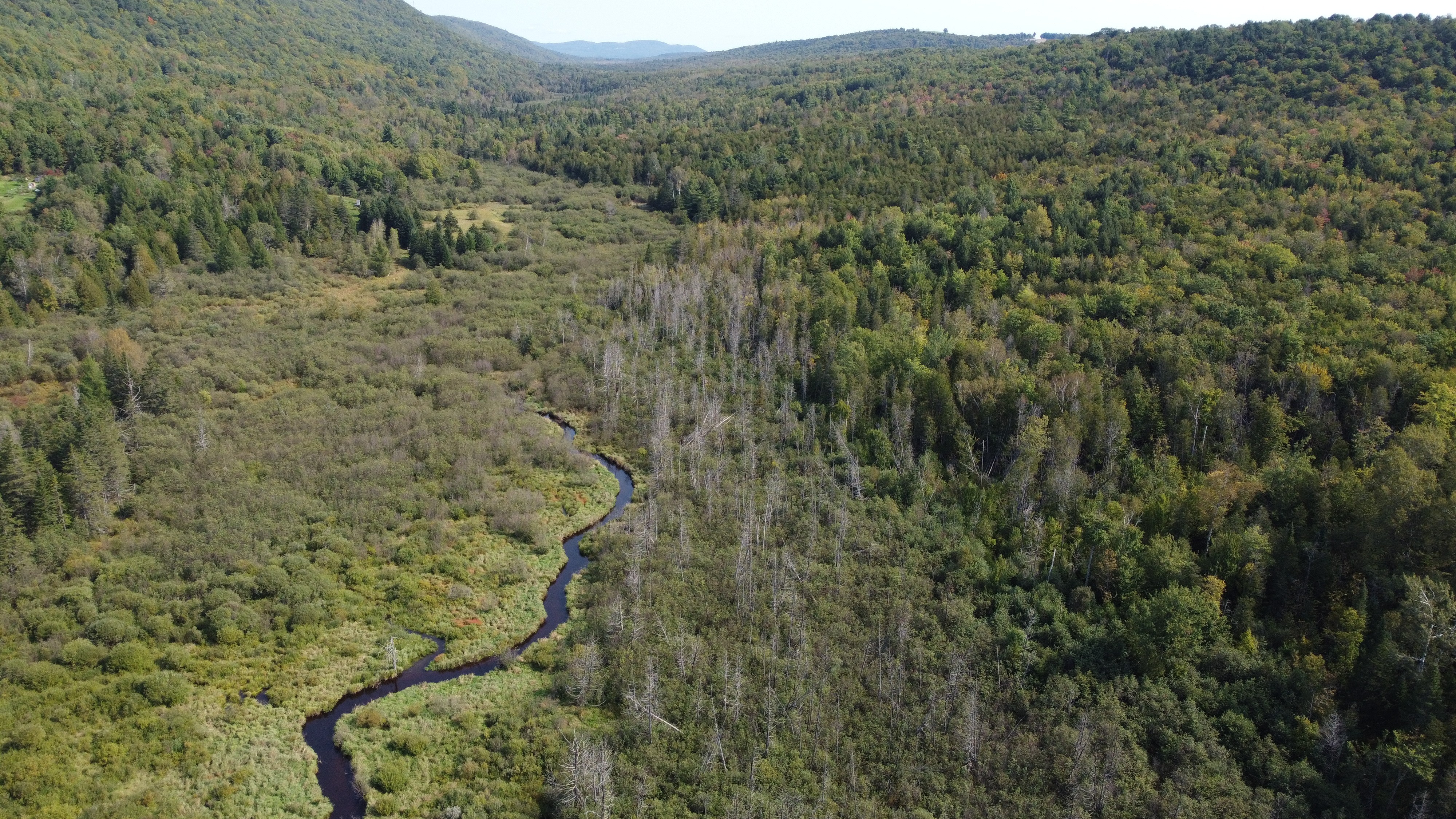Erosion
Context
MCI believes that erosion is a problem that needs to be taken very seriously. After heavy rains, Lake Memphremagog’s tributaries become loaded with sediments which end up in the lake. Each ton of sediment carries with it one kilogram of phosphorus, stimulating the growth of aquatic plants and algae. In fact, any use of the land which disturbs the vegetative cover is likely to lead to soil erosion, especially when bare soil is exposed or is rendered impermeable.
The Castle Brook delta in Lake Memphremagog as seen from the air
We can readily see the sedimentation and the proliferation of algae.

Source : RAPPEL
Just what is erosion?
Erosion is defined as the mechanism by which soil particles are detached and transported from their point of origin. As such, it is a natural phenomenon, which is only harmful to the environment when its occurrence exceeds the environment’s ability to accommodate it. However, certain human practices and land uses greatly amplify the phenomenon, especially those practices that result in exposing bare soil to the elements. This is referred to as accelerated erosion.
It is the action of water (rain or snow melt) that begins the process of erosion. This process is increased in the presence of bare soil, i.e. when the natural protection of the vegetative cover is removed. Studies show that erosion is increased 100 fold in the presence of bare soil (Purdue University, 1999). Erosion results in the silting up of aquatic ecosystems. Essentially, when a soil particle is detached from its point of origin by the action of water or wind, it becomes matter in suspension, and when it is deposited (sedimentation) it is called sediment.
Vegetation is the best way of preventing erosion, by protecting the soil from the erosive power of rainfall and runoff. Vegetation stabilizes the soil in depth, favouring the infiltration of water into the soil rather than flowing over the surface.
What are the signs of erosion?
Terrain affected by erosion will be riddled by small ravines, gullies or even crevasses. A shoreline affected by erosion becomes unstable and can break up. Areas subject to erosion will show signs of uprooted vegetation, landslides and rock falls. Brown water is not normal. When a stream or river turns brown after a rain, we are observing a serious erosion problem in the watershed. The ultimate result is siltation and eventual filling up of the waterway downstream. When the silting up process is occurring, a delta forms at the outlet of a tributary as a result of erosion in the watershed of the waterway.
What are the AGRICULTURAL practices that cause accelerated erosion?
Leaving soil bare for extended periods of time, free access of livestock to waterways, elimination of water runoff control structures in fields and pastures and excessive underground drainage all lead to accelerated erosion. Bare soil exposed during plowing is particularly sensitive to erosion, since it is completely exposed to the effects of water. Studies show that one acre of plowed soil without vegetative cover, in a shallow slope, can release up to 7 tons of soil per year into the hydrologic system (ODNR, 1996). This excessive erosion, as well as silting up waterways, also leads to a loss of productivity for the farming enterprise. Overlarge fields (with long slopes), where obstacles have been removed (such as rock dikes, hedges of trees, etc.) and with manmade surface drainage canals, greatly increase the vulnerability of bare soils to erosion after harvesting is complete. As well, in the past, the Quebec government encouraged and in part financed the drainage of agricultural land, in an attempt to increase productivity. We realize today that these policies have greatly changed the hydrologic regimes of watersheds, promoting the erosion of the shorelines of waterways, which cannot deal with the resulting large volumes and rapid flow of water reaching them. As if this were not enough, the problem is exacerbated by the effects of climate change. Finally, when livestock have free access to waterways and their shorelines, they trample the shore with their hooves, destroying the vegetation and sending significant quantities of sediments into the hydrological network.
How do FORESTRY activities promote accelerated erosion?
The removal of forest cover and the drainage of forested lands contribute to accelerated erosion, since these activities alter the hydrology of the watershed. This results in increased water flows and increased speed of these flows, with all of the attendant risks that this entails for shoreline erosion, which cannot accommodate these rapid and massive water flows. As well, repeated traffic of heavy equipment in waterways can send significant quantities of sediments into the hydrologic network.
What URBAN activities lead to accelerated erosion?
The removal of forest cover and its replacement by hard, impermeable surfaces promotes erosion. Buildings, paved roads and parking lots are impermeable surfaces which alter hydrology, preventing water from soaking into the soil, sending it rapidly into the hydrologic network. As well, this water, which cannot soak into the soil, flow on the surface, washing and eroding any bare soil encountered. Poor maintenance of roadside ditches can also be an important contributor to erosion, as this practice results in bare soil being exposed in part of the ditch. Also, poorly constructed roads and access ramps can also be potential erosion sites as a result of washout. Too often, we have seen that a poorly stabilized culvert or too shallow roadway have resulted in a roadway being washed out or, even worse, completely washed away, bringing phenomenal quantities of sediments into the aquatic ecosystems of the Lake Memphremagog watershed. For example, during the summer of 2005, the Mountain House Road was the site of a significant environmental accident. The road was completely washed out, and all of the soil from the road ended up in the downstream brook. In the same way, the road leading to Mount Orford was completely washed out by a water flow in the summer of 2008.
A sinkhole on Route 141 at the intersection with Castle Brook after a heavy rain.


CONSTRUCTION activities: erosion champions!
Construction activities necessitate the removal of a part of the vegetative cover, exposing bare soils to erosion. It is said that a denuded construction site erodes from 10 to 100 tons of soil per acre per year, a rate of erosion 10 times greater than that of agricultural land, 200 times greater than a pasture, and 2,000 times greater than the natural rate of erosion of forested land. (ODNR, 1996). It is, however, possible to carry out construction activities while minimizing the exposure of bare soil to the elements, and capturing any soils eroded before they enter the hydrologic network. These techniques must be done by competent, experienced people. For instance, in the fall of 2005, the construction site of the Memphremagog golf course resulted in a significant contamination of the lake with sediments. The heavy rainfall of the 14 th, 15 th, and 16th of October of that year caused two sedimentation ponds to overflow, washing out two dikes, allowing a large amount of sediment and other contaminants to flow into the lake. On small sites, it is generally sufficient to install geotextile sediment barriers and hay bales at the bottom of slopes, protecting nearby bodies of water and waterways from any eventual soil runoff.
Example of sediment control

How do sediments end up in the bottom of a waterway?
The process of erosion can be described in four phases:
Liberation of soil particles
when rain strikes bare soil, it acts like millions of tiny bombs, exploding the soil, which then fragments into tiny particles.
Leaching (suspending of soil particles)
Soil particles plug up soil pores, rendering the soil impermeable, forcing the water to flow across the surface rather than soaking into it. Flowing across the surface, the water concentrates in lower areas (as a function of the topography) and gains erosive force. The water then carries with it the soil particles (put into suspension) and transports them as it flows (leaching). When phosphorus particles are adsorbed by the soil particles, they are also carried along.
Creation of gullies
The small ravines created by the flow of the water gain more and more water flowing faster and faster, becoming channels, which get larger, becoming furrows, then gullies.
Deposition (sedimentation and silting)
Via the action of gravity, these gullies eventually end up joining an existing waterway and, eventually, a body of water. This sediment heavy water is brown and less accommodating of aquatic life. The soil particles remain in suspension until such time as they reach a calmer area. They then deposit on the bottom, more or less slowly, depending on their size and weight. This is sedimentation. Larger particles, such as gravels and sand generally deposit near their point of origin, often in a nearby stream. Once a significant thickness of sediments has deposited on the bottom, we say that it has silted up. The lake fills in slowly, losing depth and size. Eventually, it fills in completely and disappears.
Diagram of the erosive power of water

What are the consequences of accelerated erosion?
First of all, accelerated erosion causes a loss of topsoil, causing the loss of a range of uses: the ecosystem can no longer provide the ecological services we expect of it. These consequences cost dearly, not only from the ecological viewpoint, but also from the economic and social ones.
Loss of topsoil and usable land
Accelerated erosion causes the loss of phenomenal quantities of fertile topsoil. Cultivated land slowly loses its productive capacity. At construction sites, all the soil washed away must be replaced with fill. On the shores of lakes or other bodies of water, this erosion slowly eats away at the land. In extreme cases, entire properties can be threatened.
Reduction of potable water quality
Water charged with sediments is not potable, resulting in rapid increases in the cost of treating it.
Disturbance of the biological communities of the waterway and reduction in the quality of the fishing
Suspended sediments are a threat to the survival of the fish living in the water. The suspended particles irritate and can even completely block their gills. As well, the sediments deposit on spawning grounds, asphyxiating the eggs present there, and destroying the sites’ potential as spawning grounds for years to come. So, as well as having a serious impact on the structure of the community of fish of a body of water, erosion is a direct threat to its fishing potential.
Deterioration of swimming areas
When sediments accumulate on the bottom, they form a layer of mud that is very unpleasant to step in. As well, the accumulation of fine particles (silt) promotes the excessive proliferation of aquatic plants, which are also unpleasant in swimming areas. The entire recreotouristic services of the ecosystem are affected.
Amplification of other environmental problems
The sediments transported via erosion are often laden with contaminants and phosphorus. As we know, phosphorus is the NUMBER 1 cause of eutrophication of our waterways.
Damage to water transport infrastructure
Sediments deposited along waterways are also a menace to the proper functioning of water transport infrastructure. Thus, culverts, ditches and rainwater sewers can become plugged with sediments. The maintenance and unblocking of these infrastructures can be quite costly to the municipality or individual responsible for their maintenance, not to mention the cost of repairing roadways eroded due to these blockages.
Vulnerability to flooding
Sediments deposited on the bottom of streams and rivers can change their shape and reduce the volume that can flow through them, increasing the risk of flooding. Flood damage is very costly, economically, environmentally and socially.
What can I do?
The fight against erosion remains one of the most important challenges to improving the quality of the water of Lake Memphremagog. We must always keep in mind that the vegetation on our shorelines is our best ally in this fight. As well, some simple techniques can help prevent erosion, and capture any sediments when erosion cannot be avoided. These techniques are explained in greater detail in guides such as those listed below. However, these techniques need to be properly applied. For some simple tricks that can help you combat erosion, refer to section of the Intervenors’ Guide that applies to you.
For more information
- Ontario ministry of Agriculture, Food and Rural Affairs, 2018: Soil erosion - causes and effects


.png)






.JPG)



























.JPG)























